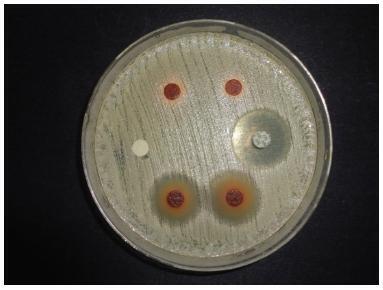Summary
Revista Brasileira de Ginecologia e Obstetrícia. 12-01-2016;38(12):593-599
To evaluate the antifungal susceptibility profile of the aqueous extract of the bark of Schinus terebinthifolius Raddi against the strains of the genus Candida.
By using the disk diffusion method, 50 samples of the genus Candida (Candida albicans; Candida krusei; Candida glabrata; and Candida tropicalis), isolated from patients receiving treatment at Hospital Santa Casa de Misericórdia de São Paulo, and 1 American Type Culture Collection (ATCC) sample of each species were tested against: the isolated aqueous extract of the bark of Schinus terebinthifolius Raddi, isolated nystatin, and the association of nystatin and the aqueous extract of Schinus terebinthifolius Raddi.
There were no significant differences regarding the different strains of Candida tested. In the presence of the aqueous extract of Schinus terebinthifolius Raddi, no inhibition halo was visible. Isolated nystatin formed an inhibition halo measuring respectively 18.50 mm and 19.50 mm for the Candida albicans species and the others referred to as non-Candida albicans (Candida krusei; Candida glabrata; and Candida tropicalis). The association of nystatin and the aqueous extract of Schinus terebinthifolius Raddi resulted in inhibition halos measuring 14.25 mm and 16.50 mm respectively. The comparisons of these results are statistically significant (p < 0,001).
The aqueous extract of Schinus terebinthifolius Raddi showed no antifun-gal activity in vitro against the strains tested, whereas the association of nystatin and the aqueous extract of Schinus terebinthifolius Raddi caused a decrease in the inhibition halo when compared with isolated nystatin.


Summary
Revista Brasileira de Ginecologia e Obstetrícia. 03-15-2010;32(2):82-87
DOI 10.1590/S0100-72032010000200006
PURPOSE: to study the clinical and microbiological profile of women with bacterial vaginosis participating in a randomized, double-blind clinical trial, which compared the vaginal use of preparations from red pepper tree and metronidazole for the treatment of genital discharge. METHODS: the study was conducted on a series of 277 women with bacterial vaginosis concomitantly diagnosed by the criteria of Amsel and Nugent, selected from a total of 462 recruited patients using the information obtained before intervention. Data were analyzed with the Epi-Info 3.32 software. In order to compare the outcomes frequencies between the intervention groups, the χ2 test was used and the risk ratio and 95% confidence interval were calculated. The intention to treat analysis was performed. In addition to the determination of diagnostic parameters, the culture of vaginal content and a Papanicolaou cytology test were also performed. RESULTS: the most frequent clinical complaints were genital discharge, observed in 206 participants (74.4%) and the fish odor of the vaginal secretion, which occurred in 68.6% of the cases (190 patients). Among the diagnostic clinical criteria, the presence of clue-cells was positive in 275 women (99.3%), the Whiff test, in 266 (96.0%), followed by pH >4.5, which occurred in 92.8% of the cases, and by the presence of fluid grayish discharge reported by 206 participants (74.4%). Regarding the Nugent criterion, the median score was 8.0. Culture of the vaginal content permitted the identification of Gardnerella vaginalis in 96.8% of cases and of Mobiluncus in 53.1%. Only one third of the exams showed the presence of Lactobacillus (89 women - 32.1%). Fungal growth occurred in the cultures of 14 participants (5.1%). In most cases, culture revealed the presence of Corynebacterium (94.2%), Gram-positive cocci (98.2%), as well as Gram-positive (99.3%) and Gram-negative (91.0%) bacilli. Oncotic colposcopy revealed a very scarce presence of lactobacilli, which were present in only 8 cytological exams (2.9%) out of the total of 273 exams performed. CONCLUSIONS: the results of the present study did not differ from the literature regarding the symptoms reported by the women, the clinical criteria most frequently observed in the diagnosis, or the bacterial species detected in cultures of vaginal content. These findings indicate the need for further studies that might better elucidate the interrelations between the microbiological findings and the clinical expression of bacterial vaginosis.
